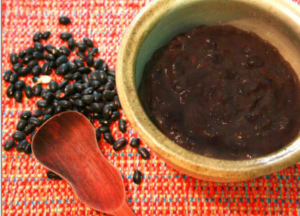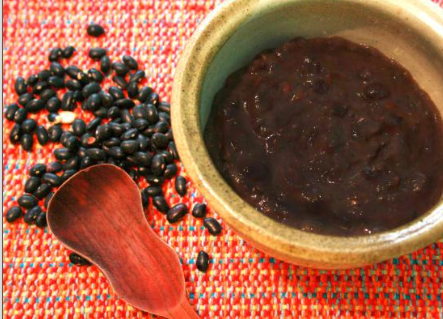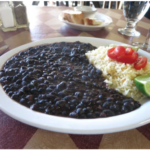The black beans, black grains, beans or black beans, represent part of the gastronomic heritage of Venezuela. Three kinds of beans are consumed in the country: red beans, white beans and black beans.

Caritas a la caraqueña are eaten with sugar, which is why they are prepared low in salt. At the moment of serving them, sugar or paper is added… Divine! I love them like that.
Well, in Venezuela the black beans are part of one of the most emblematic and representative dishes, the Creole pavilion, and precisely the recipe that we bring you is none other than the black beans for pavilion, so do not miss the details and learn how to prepare this delicacy of Creole gastronomy.
Ingredients to make Black beans for pavilion:
- 500 grams of black beans
- 1 teaspoon of Bicarbonate
- 1 large onion
- 6 sweet peppers
- 6 garlic cloves
- 1 green pepper
- 1 teaspoon Cumin
- 1 pinch of salt
- 1 pinch of sugar
- 1 branch of Cilantro
How to make black beans for pavilion:
- Select the beans on a preferably white plate and remove the stones and twigs you find. Use another container to place the selected beans.
- Soak the grains and add the baking soda. Let stand for 24 hours and make sure the container is deep and the water is two fingers above the beans, as they will grow a little.
- Stir the water well and remove any grains that float, and then cover the container and reserve until the next day.
- The next day, drain the beans using a strainer. Wash them with plenty of water.
- To cook our black beans, boil the beans for a while. When they boil, discard the water with the foam they give off. Pour water back into the pot until it completely covers the beans and continue cooking.
- Tip: Why is the first cooking water discarded? To reduce the unpleasant effect of flatulence produced by beans after consuming them.
- While we cook the Venezuelan beans, chop all the vegetables, those that will serve for the base sauce and, on the other hand, and those that we will use to flavor the grains.
- Then, wash and chop everything into small squares, except the paprika, a chili pepper, the half onion and the coriander. Booking. Cut the paprika into 4 parts, this can be red or green, but the beans are much better with green pepper.
- Check that the water in the cooking pot completely covers the beans. Add the paprika, chili, onion and cilantro to taste and keep the pot over medium-high heat.
- When the grains soften a bit, remove the paprika, coriander and onion.
- Tip: Let the grains soften before adding the salt; otherwise they will not soften and will be hard
- Separately, in a pan or saucepan, make the base sauce with the onion first, until it browns a little without burning, then the garlic and finally the rest of the vegetables. Stir constantly.
- This recipe is for beans for the pavilion, a complete dish that has white rice, shredded meat and slices of plantain, but if you want to make only black beans, you can add some meat to the sauce, such as pork, chops or chorizo.
- When the sauce is at its point, empty everything into the pot with the caritas and stir so that the flavors are integrated.
- Now add a bay leaf and turn off the heat when you consider that the beans for the pavilion have the desired consistency. It all depends on your taste, if you prefer more broth or less.
- Trick: There are those who add chopped coriander at the end, 5 minutes before turning off.
- Wait for them to rest for a few minutes and that’s it, how delicious are these black beans for the pavilion! Although the recipes vary in some details, from house to house and from state to state, the basics remain the same.
- Venezuelan beans can be eaten as an accompaniment to the typical Creole pavilion, in areas, in empanadas, alone, with sardines and even…with pasta! I particularly love spaghetti with black beans. My mouth is watering!
- Also, when serving them you can add sugar, a splash of olive oil or grated white cheese. To enjoy!
- What do you know about black beans?
- In Venezuela they are known as black beans, but depending on the region, the different native peoples of America gave these grain different names. The Aztecs called it tell, the Mayans bull or quinsonch’ and the Incas purity. The Cumanagotos of Venezuela knew it as caritas and the Cha-chas of Colombia as haste; while in the Caribbean he called them sister-in-law.
- Around the world, they are also given other names: beans, peas, beans, grains, kidney beans or beans.
- The common bean, according to studies, comes from Mesoamerica. Today there are many kinds of beans, both wild and cultivated, and archaeological evidence has been discovered in Peru showing that about two thousand years BC, beans were grown in the Americas.
- The nutritional properties of grains are famous all over the world. Black beans are essential in any vegetarian or vegan diet due to their high protein content. Like meat, black beans can provide us with all the amino acids that the body needs but with little saturated fat and “0” cholesterol.
- In addition, beans have more antioxidants than any other legume. Black beans are rich in fiber, both soluble and insoluble, keep cholesterol at bay, level blood sugar, among others, and are a great source of minerals.




